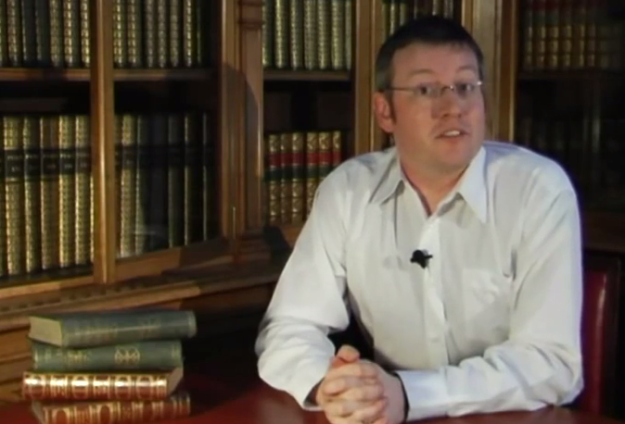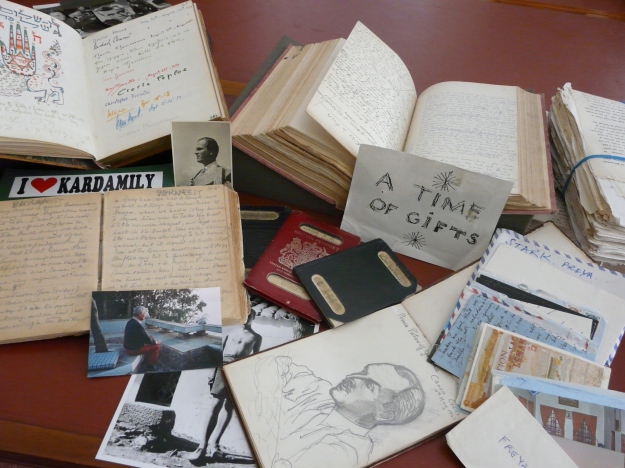Many blog readers and members of the PLF Society were privileged to her John Julius Norwich give a very personal account of his memories of Paddy at the Hellenic Centre in London on 10 November. My account of the evening is here.
I am very lucky to be able to present the full transcript of the talk. Didn’t I say we had some good stuff coming up? Enjoy this 🙂
On 22 February 1951 my mother wrote to me: “Just off for my jaunt to Passy sur Eure to spoon with P. Leigh Fermor. Shy. Fluster.” At that time she had only just met Paddy and hardly knew him, and she would have been – as indeed she confessed she was – extremely nervous. But all was well. The next letter read:
Well, the gallivanting was a red letter. It took me a good two hours cross-country by Pontoise and Mantes. Strange little village house in which he lives – the loan of a Lady Smart – was warm and welcoming and I really felt myself back in the pond I was raised in. Fascinating conversation with a male man who delights in one. Paddy was superb. Cultured, funny, telling wonderful sagas, zealous. We had a charming filthy little lunch over the stove of sardines, Pernod and vin ordinaire and afterwards we walked for two hours over low wooded downs in sparkling sun, talking ten to the dozen about people, grievances and enthusiasms
That was the beginning. My parents saw quite a lot of Paddy and Joan – whom my mother thought looked just like Joan of Arc, except that Joan of Arc didn’t wear sun-glasses – in the next year or two. I was at Oxford at the time, and I remember seeing them once or twice during vacations, and being invariably knocked sideways – as everyone was – by the sheer brilliance of Paddy, and the glorious fun of him. Every time he walked into a room it was as if the sun had come out; never have I laughed more uncontrollably round a luncheon or dinner table, and as for his erudition, never have I met anyone who knew so much about everything under the sun, yet wore his learning so lightly. There seemed to be no language he could not speak, or indeed sing songs or recite poetry in: French, German, Italian, Spanish, Greek and Rumanian for a start, but there were probably several others as well.
Then, in the summer of 1955, a wonderful thing happened. By then I had joined the Foreign Service. My first wife Anne and I were by that time living in Belgrade, where I was Third Secretary at the British Embassy. Another letter arrived from my mother. She had been lent a Greek caïque by the ship-owner Stavros Niarchos for a fortnight’s sail through the isles of Greece. Paddy and Joan were coming; could we come too? As far as we were concerned, it was a question of “can a duck swim?” At the end of August we drove down from Belgrade – which in those days had no airport – to Athens, and thence to the Piraeus, where we boarded the Eros.
It was my first time in the Aegean, and Paddy gave it a whole new dimension. It was the first time I had seen him, as it were, on his home ground, and it was wonderful. He lived and breathed his beloved Greece – fluent in its language, encyclopaedic in his knowledge of its history, its customs and its literature. But nobody – and that was the wonder and joy of him and – I know I’ve said this before – nobody has ever carried his learning more lightly. His conversation was consistently dazzling. As we sailed from island to island – and in those days there were virtually no tourists, and I can’t begin to tell you what a difference that made – he talked about Greece, about Greek history, about Greek beliefs and traditions, about Byron and the Greek War of Independence, with those monstrously magnificent Greek heroes – men like Mavromichalis and Kolokotronis whose names roll so satisfactorily across the tongue – and about the Greek Orthodox Church and its quarrels with the west over more of those words, like filioque and ͑ομοούσιον; but his talk roamed far wider than that, taking in the whole eastern Mediterranean and, in particular, Byzantium.
Now in England Byzantium has always had a terrible press. The great nineteenth-century historian W.E.H. Lecky wrote that it constituted, “without a single exception, the most thoroughly base and despicable form that civilisation has yet assumed…. There has been no other enduring civilisation, he claimed, “so absolutely destitute of all the forms and elements of greatness”. He went on,
Its vices were the vices of men who had ceased to be brave without learning to be virtuous…. Slaves, and willing slaves, in both their actions and their thoughts, immersed in sensuality and in the most frivolous pleasures, the people only emerged from their listlessness when some theological subtlety, or some chivalry in the chariot races, stimulated them to frantic riots…. The history of the Empire is a monotonous story of the intrigues of priests, eunuchs and women, of poisonings, of conspiracies, of uniform ingratitude, of perpetual fratricides.
Strong words indeed – although to modern ears that last sentence makes Byzantine history sound not so much monotonous as distinctly entertaining. But that long campaign of denigration continued well into the twentieth century. It was only in the time of which I’m speaking – the fifties – that the writings of people like Robert Byron, David Talbot Rice and Steven Runciman, together with the new-found ease, speed and relative comfort of travel in the Levant, made the glorious heritage of the Byzantine Empire at last generally accessible. Now, thank heaven, the Empire has come into its own again, and is seen as a worthy successor to the two mighty civilisations which it followed and so beautifully combined, the Greek and the Roman.
The trouble was, for most of us, that we knew so little about it. Those old attitudes died hard. During my five years at Eton, the entire subject was the victim of what seemed to be a conspiracy of silence. I can’t honestly remember Byzantium being once mentioned, far less studied; and so complete was my ignorance that I should have been hard put to define it even in general terms till I went to Oxford. And, for heaven’s sake, why? After all, it was not even the successor, it was that same old Roman Empire of Augustus and Tiberius and Claudius and the rest, which continued to exist in its new capital of Constantinople for another one thousand, one hundred and twenty-three years before it was finally captured by the Ottoman Turks on that fateful day, Tuesday 29 May 1453, after one of the most heroic sieges in all history. It was Paddy and Paddy alone who revealed to me its mystery and its magic, although he also recommended to me, among much else, that I should read an extraordinary book by Robert Byron, The Byzantine Achievement, which that most precocious author wrote when he was twenty-five. I read it with utter fascination, and ended up completely captivated. When I got home I devoured every book I could find on the subject, and the following year Anne and I drove to Istanbul for a week. Twenty years later I was to write a History of Byzantium myself – three volumes of it, which were necessary if I was to cover more than a millennium; but I very much doubt whether, had it not been for that fortnight on the Eros, those three volumes would ever have been written.
One evening, I remember, Paddy was talking about a poor fisherman at Kardamyli – this was long before he went to live there – a friend of his called Strati Mourtzinos, who, he told us, might just possibly have been the last heir to the imperial throne of Byzantium. Suddenly his imagination took over, and he built a magnificent castle in the air. It seemed, by some miracle, that the Turks had restored Constantinople to Greece. Byzantium was reborn and Strati Mourtzinos was formally crowned as its Emperor. Paddy was later to work up the idea further in his first book about Greece, Mani:
Bells clanged; semantra hammered and cannon thundered as the Emperor stepped ashore. Then, with a sudden reek of naphtha, Greek fire roared, saluting in a hundred blood-red parabolas from the warships’ brazen beaks….. In the packed square of Constantine, a Serbian furrier fell from a rooftop. An astrologer from Ctesiphon, a Spanish coppersmith and a money-lender from the Persian Gulf were trampled to death; a Bactrian lancer fainted and, as we proceeded round the Triple Delphic Serpent of the Hippodrome, the voices of the Blues and Greens, for once in concord, lifted a long howl of applause. The imperial horses neighed in their stables, the hunting cheetahs strained yelping at their silver chains. Mechanical gold lions roared in the throne room, gold birds on the jewelled branches of artificial trees set up a tinkling and a twitter. The general hysteria penetrated the public jail: in dark cells, monophysites and bogomils and iconoclasts rattled their fetters across the dungeon bars. High on his Corinthian capital, a capering stylite, immobile for three decades, hammered his calabash with a wooden spoon….
Would you like a bit more? All right: Continue reading →













